Bridles are used to control horses and achieve desired performance. Although horses can be worked without them or with substitutes, a bridle with one or two bits can add extra finesse. The bridle allows you to communicate and control your mount.
For it to work properly, you need to select the bridle carefully according to the needs of you and your horse as well as the type of performance you expect. It must also be assembled correctly. Although there are many styles of bridles, the procedures for assembling and using them are similar.
The three basic parts of a bridle
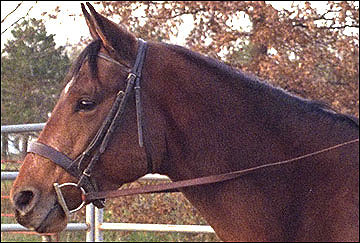
All bridles have three basic parts: bit, reins and headstall (Figure 1). The bit is the primary means of communication. The reins allow you to manipulate the bit and also serve as a secondary means of communication. The headstall holds the bit in place and may apply pressure to the poll.
The bit is the most important part of the bridle because it is the major tool of communication and control. Choose one that is suitable for the kind of performance you desire and one that is suitable for your horse.
Measuring the bit
Finding the correct size is important. Mouthpieces vary from 4 to 6 inches in width. Most average-sized pleasure horses require about a 5-inch mouthpiece. The easiest way to determine the correct width for your horse is to try several different sizes. If this is not possible, use a ruler to take this measurement.
A correctly fitting bit is wide enough to accommodate the horse's jaw with the sidepieces just touching the lips on each side. A bit that is correctly fitted does not pinch the corners of the horse's mouth.
If the bit is too wide, the mouthpiece protrudes beyond the lips. It will slide back and forth in the horse's mouth and result in confusing rein signals. Also, if the mouthpiece is jointed, it will put extra pressure on the outside corners of the bars and cause pain.
The cheekpieces and shanks of curb and Pelham bits must also fit properly. If the horse has a narrow mouth and heavy jaws, you might bend them outward slightly. Cheekpieces must lie along the horse's cheeks. They must neither pinch nor protrude. Shanks must clear the lower jaw.
Selecting the headstall
Since most headstalls perform the same functions, your only choice is whether they will be English or Western or whether they will match the rest of the equipment. Even then, a wide variety of styles is available, and the only rules for choosing a headstall are personal preferences.
No matter whether you choose a simple Western headstall or one of the most complicated, they will be assembled and adjusted in much the same way.
Bridle assembly
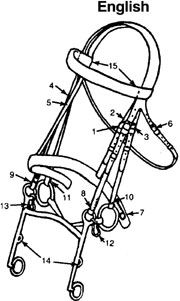

- Left cavesson cheekpiece
- Left curb headstall cheekpiece
- Left bridoon cheekpiece
- Right curb headstall cheekpiece
- Right bridoon cheekpiece
- Throatlatch
- Cavesson
- Left curb bit attachment
- Right curb bit attachment
- Left bridoon attachment
- Right bridoon attachment
- Left curb chain hook
- Right curb chain hook
- Lip strap hooks
- Browband
Most English bridles and many Western bridles include a browband (Figure 2). This strap goes around the front of the horse's forehead. The first step in assembling a bridle with a browband is to put the browband on the cheekpieces or crownpiece and slip it into its approximate final position.
Western bridles may incorporate one or two ear loops instead of a browband. The loops may be built in or slipped on. If they slip on, this is the time to attach them. If there are separate cheekpieces, attach them to the bottom of the crownpiece.
Bit
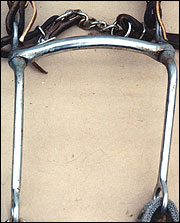
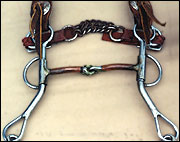

The bit is the most important part of the bridle. It should be appropriate for the activity, correct in length of mouthpiece, and should be held by the headstall at the appropriate height in the horse's mouth (Figures 3, 4 and 5).
Attach the bit to the bottom of the cheekpieces. If your bridle has no browband, this is the first step.
Double bridles have two bits and are more complicated. The snaffle bit, called a bridoon, usually has its own separate crownstrap with a single cheekpiece. If so, it fits into the bridle underneath the headstall of the curb bit, with the single cheekpiece buckling on the left side.
A double bridle also may have its own special crownpiece. Attach both bit and bridoon cheekpieces to this crownpiece. The curb bit cheeks are in front. Next attach the bridoon cheeks to the throatlatch.
Now attach a noseband if you will be using one. A regular, built-in noseband slips through slots on the cheekpieces. A separate noseband has its own straps for attachment and is called a cavesson noseband. Its crownpiece goes under the crownpiece of the bit with the single cheekpiece of the cavesson buckling on the left side.
Headstall
If the throatlatch is not a part of the headstall, place it beneath all other pieces in the assembly. If a cavesson noseband is also used, the order from the inside to the outside should be throatlatch, cavesson, bridoon headstall (if used), and bit headstall.
Another alternative is to use a browband sewn with two slots and to run the throatlatch through the end slots. This arrangement is very popular with Western bridles and is standard equipment on most race bridles.
If you are using a curb-action bit, attach the curb chain or strap. Most English bridles require hooks and chains for attaching. Attach the hooks to the headstall rings with the open part to the outside. Then, attach the chain so it will lie flat across the bit with the center ring for the lip strap free on the bottom of the chain. Next, clamp the right hook tightly to the chain but leave the left one loose for easy unhooking.
Most English bridles requiring curb chains also have lip straps. Attach the lip strap to the small loops on the shanks of the bit. Keep the short end of the buckle on the left shank and the long end on the right shank. Then, pass the long end through the curb chain ring and buckle the strap.
Lip chains serve the same purpose as a leather strap but will last longer. They also are easier to attach because they hook into the lip strap loops. Clamp the hooks down tightly after making certain that both chains are lying flat.
Most Western bridles use leather or part leather and part chain curb straps instead of the flat English chain. Attach the curb strap to the special slots in the bit if they are provided. Do not fasten the strap to the snaffle ring of a Pelham bit. When there is no slot on a Western bit, attach the curb strap to the headstall rings.
Reins
Reins are available in many materials and many designs. The primary purpose of these varied styles is to increase their efficiency according to their particular purpose. Reins with chain ends are made especially for use with spade bits; they provide the extra weight that helps the bit hang properly.
Most reins are readily installed either by lacing or buckling them to the bit loops. If there is a buckle in the center of the reins, make certain that the end of the buckled rein points to the right side of the horse.
A common way to attach Western reins without buckles is with two long cuts near the bridle ends, which serve as loops. However, simpler methods are available. Many reins are simply snapped to the bit. Another innovation is called a Chicago screw. It is simply a screw with a fancy cover that is fastened through holes in the reins.
English reins may be sewn directly to the bit. This is the most professional method of attaching reins. However, unless you are sure you will not want to change bits, it is inconvenient. A more common fastening method is the hook-stud style.
Most English reins come in plain leather, which may be dressed up with lacing. Originally developed for use in hunting, the lacing adds extra grip, which is helpful for competitive riders.
Braided reins also are available. They provide even more grip than laced reins, but may be uncomfortable unless the rider wears gloves. However, braided reins are inconvenient because they stretch under pressure.
Web reins are also popular. They do not stretch, rot or crack as easily as leather. They offer more grip than plain leather and are especially popular for competitions such as three-day events and horse trials.
If your bridle uses a single rein, attachment is simple. But many English and some Western bridles require a double set of reins. In this case, the wider rein is attached to the snaffle and the narrower rein to the curb. If one rein is laced or braided, attach it to the snaffle.
Western reins come in split or closed styles. Closed reins are fastened together and may be finished California-style in a romal. The advantage of closed reins is that if you drop them, you don't lose them completely.
Split reins are especially helpful for riders who must dismount frequently. Split reins are a necessity for horses that ground tie.
Length and width of reins are other considerations. Long reins are easier to use than short ones. However, long, closed reins can tangle in your feet. Wide reins are better for cueing because the horse feels them more readily. However, a well-trained horse can pick up signals from very narrow reins. Narrow reins also are less bulky in the hand and have a neater appearance.
Attaching the reins to the bit is the last step in assembling a bridle. Fasten them with the outside of the leather or other material away from the horse.
Bridling your horse
Once you have the bridle together, putting it on the horse is fairly simple. Make certain that the bridle is large enough or even too large, before you try to put it on. The horse will be much more willing to cooperate if it is not being hurt by the bit jamming up into the corners of its mouth.
To carry the bridle, slip your left arm under the crownpiece from front to back. Carry the bridle draped over your left forearm in the crook of your elbow.
Carry the reins in your left hand. Make certain they are in proper alignment with the bridle.
Approach the horse and grasp either the halter or the mane. Holding its nose may also help to restrain the horse.
Holding either the halter or the nose with your left hand, slip the reins over the horse's head with your right hand. Putting the reins over the head is a way to restrain the horse without using its halter. Keep the reins high on the neck within easy reach.
If the reins are split, put the right rein under the horse's neck and bring it back over the top. Then, place the left rein over the horse's neck and let it hang down on the other side. In this way, they are in riding position but will not interfere with putting on the bridle.
If your horse is wearing a halter, remove it and rebuckle it immediately around the neck. This procedure gives additional control. If the horse has been tied, unfasten the tie rope from the halter. It is not safe to bridle a horse while it is tied.
If your horse misbehaves, you can grasp either reins or halter or both with your right hand. Hold them tightly and grab the horse's nose with your left hand. This will give you control of its head. If you are carrying your bridle properly on your left arm, it will be out of the way, and you will not drop it.
The bridling procedures you use depend on the size of the horse, its training and your equipment. If you are short, you may find it more convenient to put your right arm under the horse's jaw to hold the cheekpieces. However, you have less control with this method.
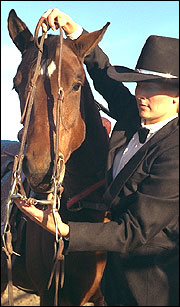
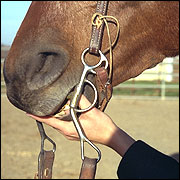
If you are tall or if you want to have more control over your horse, place your right arm around the horse's neck and up between the ears to grasp the crownpiece of the bridle (Figure 6). If the horse pulls away, you will have a much easier time restraining it.
With your right hand, lift the bridle by the crownpiece. Use your left hand to guide the bit to the horse's mouth. Hold the bit with the first three fingers.
If you use a double bridle with two bits, lay them across the palm of your left hand with the bit between the tips of your index and middle fingers. The bridoon should be between the tips of the middle and ring fingers. The bridoon goes into the mouth first.
A well-trained horse usually opens its mouth when you press gently against its lips. If the horse does not open its mouth, slip your thumb and little finger into its mouth behind the incisors (Figure 7). There are no teeth in that spot, so the horse cannot bite you. If it is persistent, you may have to apply pressure.
When the horse opens its mouth, lift the bit or bits into the mouth by pulling up with your right hand. Guide the bit with your left hand. Be firm but not abrupt.
Holding the bridle up with one hand leaves the other hand free to slip it onto the head. Fold the ears forward carefully one at a time. Slip them gently under the crownpiece or into the ear loops. Do not pull the crownpiece back over the ears because it hurts and will make the horse head-shy.
Final bridle adjustments
As soon as the bridle is in place, make all the necessary adjustments. Most bridle parts have a wide range of adjustment and fit nearly any pleasure horse larger than a pony.
The length of the cheekpieces determines where the bit will rest in the mouth. This adjustment may be made on one or both sides of the bridle. On some bridles, it is at the top of the crownpiece. Adjust the cheeks, so the bit makes one small wrinkle in the corner of the horse's mouth.
If the cheekpieces are too long, the bit will be too low in the mouth. This way it puts too much pressure on the tongue and may bump against the front teeth. It also permits the horse to put its tongue over the bit easily. When the reins are tightened, the cheeks of the bridle become slack and will bother the horse.
If the cheekpieces are too short, the bit will be too high in the horse's mouth, resulting in too much pressure at the poll and pinching at the corners of the mouth. The horse will be uncomfortable and may start to throw its head or try to spit out the bit. Eventually, the horse may become unresponsive to rein signals.
A noseband must also be adjusted properly, especially if it is a cavesson. This type of noseband is used as an attachment for a standing martingale or tie-down. Most cavessons have one long strap with a buckle at the left side. Adjust the noseband to lie about 2 inches below the point of the horse's cheekbones.
It the noseband is adjusted too high, it will be ineffective because it cannot keep the horse's head down with a martingale. It may also rub and irritate the cheeks.
If the noseband is too low, it can interfere with breathing. When a low noseband is attached to a standing martingale, it can break or injure the fragile nasal bones and tissues.
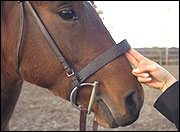
Adjust the noseband so it has about two or three fingers' width of slack (Figure 8). A loose noseband loses its effectiveness because it cannot work properly with a martingale. It is more likely to break and looks unattractive.
A tight noseband prevents the horse from opening its mouth. If you want to keep your horse's mouth shut, use a dropped noseband. It is especially important if you use a curb-action bit to make certain the noseband is not too tight. Never use a dropped noseband with this bit. A horse wearing a curb bit must be able to open its mouth to relieve pressure.
Many Western nosebands are attached too low on the headstall for use with a tie-down. In this position, the noseband can injure the horse if attached to a tie-down. However, if you think such a noseband is attractive, use it as decoration only.
If you are a stock seat rider and need a tie-down, consider a pencil bosal. It makes an excellent, fashionable cavesson for use with a tie-down. Attach the bosal to a thin headstall of its own and slip it onto the bridle under the regular crownpiece.
With the curb or Pelham bit, one of the most critical adjustments on the bridle is the curb strap or chain. The bit will not work properly unless this adjustment is correct. Fasten the curb strap so that the bit will rotate about 45 degrees in the horse's mouth before the curb begins to apply pressure.
If the curb strap is too loose, the bit will turn too far in the mouth before the curb contacts the lower jaw. When this happens, too much of the bit's action will be lost and you will lose control of the horse. The horse may pay little attention to the bit and develop a hard mouth.
If the curb strap is too tight, the shanks of the bit will not rotate far enough before the curb takes effect. Even the slightest pressure on the reins causes tightening. The horse may become afraid to work up into the bit. It will over-flex, throw its head and continually fight to stop the pain.
Another problem is that curb straps can pinch the horse's lips. This happens most frequently with horses with shallow mouths and fleshy lips, especially if you use a wide curb strap. When you apply rein pressure, the skin catches between the bit and the curb strap. Instead of attaching the curb strap directly over the mouthpiece in the bridle ring, attach it to a special curb slot.
Horses with deep, long mouths also have trouble with curb straps. With these horses, the straps apply pressure on the jaw too high up instead of in the chin groove. To solve this problem, change to a double bridle for an English horse, or use a bit with a low curb attachment on a Western horse.
You should buckle a Western curb strap onto the bit. You will not need to unfasten it after the initial adjustment except for cleaning. To attach an English chain, twist it in your fingers until it is flat. Then insert it over the left hook into one of the links near the end. Check the adjustment by rotating the shank of the bit in your hand.
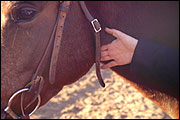
The function of the throatlatch is to keep the horse from rubbing off the bridle. It should not interfere with the rest of the bridle or with the horse. When properly adjusted, the throatlatch should accommodate at least three fingers between the throat and the strap (Figure 9).
A tight throatlatch cuts off breathing and causes the browband to ride up on the base of the horse's ears. This eventually causes sores and may make the horse head-shy. However, if the throatlatch is too loose, it cannot hold the bridle in place.
Removing the bridle
Remove the bridle in exactly the opposite way you put it on. Leave the reins around the horse's neck. Buckle the halter around the neck. Unbuckle the throatlatch and noseband. Unfasten the curb chain if you are using one.
Grasp the crownpiece, lift up slightly and pull forward at the same time. It should slip off easily. Be careful not to drop the bit on the horse's teeth. Let it slide down gently. Most horses know how to open their mouths and will let the bit slide down gently, but some do not.
Once the bridle is off, slip it into carrying position on your arm. Replace the halter and remove the reins from the horse's neck.
Safety
As in all phases of horse management, operations go much more smoothly if you practice basic safety precautions. If your horse is tied, always untie it, then bridle the horse before saddling. A tied horse frequently pulls back and may break loose. Bridling first is safer because if the horse gets away from you, at least it will not be dragging the saddle behind it.
In general, if you are careful to choose the bridle for proper fit and if you care for it diligently, adjust it correctly and use it carefully, your horse will enjoy your attention and may even look forward to its work.